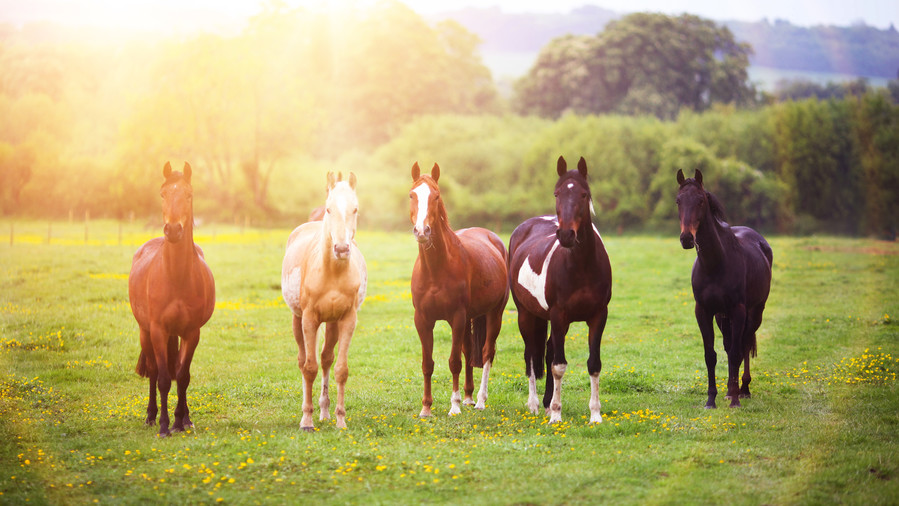Calorie counting this spring

Spring is of course prime time for equine weight gain, and many owners struggle to maintain a trim equine waistline.
To get an idea of healthy equine weights, owners should have a look at the equine condition scoring index – the Blue Cross provides some excellent advice in this field, and advises splitting the horse into three areas; the neck and shoulders, the middle, and the quarters. This is because many horses carry their fat unevenly on their bodies, so ideally, owners should ‘average’ the scores of the different three areas. (E.g. we may see a horse that looks ‘ribby’, but is actually overweight, because it carries a lot of fat on its neck and quarters, the Blue Cross advises.)
The organisation suggests looking for excessively fat areas on the horse, using our hands as well as our eyes – fat will feel spongy under the fingers, and muscle, more firm. In a healthy equine, we should be able to see muscles, and feel where the bones are.
High risk areas of the horse’s body that may indicate excess equine weight:
*The back – fat along the backbone, that has built up either side of the spine, creates a ‘gutter’. (The equine back should be flat, or should form only a slight ridge).
*Shoulders – fat can ‘fill’ in the natural hollow in front of the shoulder. (There should ideally be clear definition around the shoulder blade).
*Ribs – there should be a little fat between the ribs, but not over them. (The horse or pony’s ribs should ideally not be visible, but should be easily felt.)
*Pelvic areas – we should be able to see the bony points of the pelvis, e.g. the croup, and point of hip. (We should be able to see and feel the equine’s bones!)
*The quarters – if we stand behind the horse and see an ‘M’ shape, with a ‘gutter’ along the backbone, there’s excess fat. (The hind end should slope down very slightly, away from the croup, with the hip bones just visible.)
Download the Blue Cross’ Body Score Chart for more info.
What can we do if our horse or pony carries too much weight?
(1) Firstly, be hyper-aware of laminitis risk – certain weather conditions can significantly increase the levels of non-structural carbohydrates (NSC) in the grass. Owners can check their phone’s App Store for the ‘Laminitis app,’ a grazing risk monitoring service that alerts horse owners when their horse is at a higher risk of laminitis, due to a potential increase in grass sugars. In these situations, at risk horses should have limited access to pasture. Owners should also always try to maintain a healthy work versus feed balance with their horse, and seek their vet’s advice regarding a turnout and exercise regime, if required. (2) Consider a grazing muzzle, either as part of a laminitis management plan with the Laminitis app, (e.g on the days when the owner knows the NSCs are at a high risk), or simply as a regular management tool, to help reduce grass intake. We like USG’s Grazing Muzzle; it is made from robust nylon, and is padded around the nose, for comfort. It’s fully adjustable, in four sizes, from Small Pony to Full. Owners can also try to utilise strip grazing, to reduce overall grass consumption. (3) Use a weigh tape to monitor equine weight gain and loss, without using maths, or a scale. Even though weigh tapes aren’t as accurate as veterinary equine scales in terms of ascertaining the horse’s weight, they’re very good for keeping an eye on weight gain or loss, and do provide an estimate of weight, in either pounds or kilograms. We like Red Gorilla’s Weigh Tape – it is made from double-sided PVC, and packed in a plastic wallet with a card insert and header. (4) Owners can also talk to their feed manufacturer about the equine’s ideal diet, and how best to ensure the ideal ratios of vitamins and minerals, without providing excess starch.(Many of us have little input into the available grass, e.g. if our horses are at livery, but it is worth trying to understand the history of the site that our horses graze on. Natural meadows are the ‘gold standard’ of equine grazing, but are less commonly seen. Most of our grazing is a modern ryegrasses blend, originally designed to fatten cattle and sheep, with a high sugar and low fibre content.)
Hucklesby Associates offers a wide range of items to the equestrian trade, from horsecare and horsewear, to yard accessories and tack.
Hucklesby Associates Ltd
20 Bertie Ward Way, Rash’s Green Ind Estate, Dereham, Norfolk, NR191TE
[email protected]
01362 696309
My Account / Register